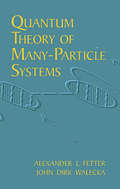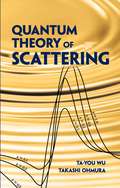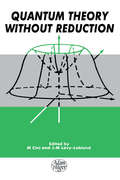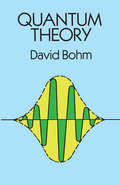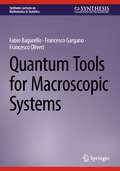- Table View
- List View
Quantum Theory of High-Energy Ion-Atom Collisions
by Dzevad BelkicOne of the Top Selling Physics Books according to YBP Library ServicesSuitable for graduate students, experienced researchers, and experts, this book provides a state-of-the-art review of the non-relativistic theory of high-energy ion-atom collisions. Special attention is paid to four-body interactive dynamics through the most important theoretical
Quantum Theory of Many-Body Systems
by Alexandre ZagoskinThis text presents a self-contained treatment of the physics of many-body systems from the point of view of condensed matter. The approach, quite traditionally, uses the mathematical formalism of quasiparticles and Green's functions. In particular, it covers all the important diagram techniques for normal and superconducting systems, including the zero-temperature perturbation theory and the Matsubara, Keldysh and Nambu-Gor'kov formalism, as well as an introduction to Feynman path integrals. This new edition contains an introduction to the methods of theory of one-dimensional systems (bosonization and conformal field theory) and their applications to many-body problems. Intended for graduate students in physics and related fields, the aim is not to be exhaustive, but to present enough detail to enable the student to follow the current research literature, or to apply the techniques to new problems. Many of the examples are drawn from mesoscopic physics, which deals with systems small enough that quantum coherence is maintained throughout their volume and which therefore provides an ideal testing ground for many-body theories.
Quantum Theory of Many-Particle Systems
by Alexander L. Fetter John Dirk Walecka"Singlemindedly devoted to its job of educating potential many-particle theorists...deserves to become the standard text in the field." -- Physics Today"The most comprehensive textbook yet published in its field and every postgraduate student or teacher in this field should own or have access to a copy." -- EndeavorA self-contained, unified treatment of nonrelativistic many-particle systems, this text offers a solid introduction to procedures in a manner that enables students to adopt techniques for their own use. Its discussions of formalism and applications move easily between general theory and direct use by offering illustrations of principles to specific cases.Chapters on second quantization and statistical mechanics introduce students to ground-state (zero-temperature) formalism, which is explored by way of Green's functions and field theory (fermions), Fermi systems, linear response and collective modes, and Bose systems. Finite-temperature formalism is examined through field theory at finite temperature, physical systems at finite temperature, and real-time Green's functions and linear response. Additional topics cover canonical transformations and applications to physical systems in terms of nuclear matter, phonons and electrons, superconductivity, and superfluid helium as well as applications to finite systems.Graduate students will find this text enormously practical in making the transition from taking courses in quantum mechanics to interpreting the vast quantity of literature concerning the many-body problem.
Quantum Theory of Materials
by John D. Joannopoulos Efthimios KaxirasThis accessible new text introduces the theoretical concepts and tools essential for graduate-level courses on the physics of materials in condensed matter physics, physical chemistry, materials science and engineering, and chemical engineering. Topics covered range from fundamentals such as crystal periodicity and symmetry, and derivation of single-particle equations, to modern additions including graphene, two-dimensional solids, carbon nanotubes, topological states, and Hall physics. Advanced topics such as phonon interactions with phonons, photons and electrons, and magnetism, are presented in an accessible way, and a set of appendices reviewing crucial fundamental physics and mathematical tools makes this text suitable for students from a range of backgrounds. Students will benefit from the emphasis on translating theory into practice, with worked examples explaining experimental observations, applications illustrating how theoretical concepts can be applied to real research problems, and 242 informative full color illustrations. End-of chapter exercises are included for homework and self-study, with solutions and lecture slides for instructors available online.
Quantum Theory of Scattering
by Takashi Ohmura Ta-You WuThis volume addresses the broad formal aspects and applications of the quantum theory of scattering in atomic and nuclear collisions. An encyclopedic source of pioneering work, it serves as a text for students and a reference for professionals in the fields of chemistry, physics, and astrophysics. The self-contained treatment begins with the general theory of scattering of a particle by a central field. Subsequent chapters explore particle scattering by a non-central field, collisions between composite particles, the time-dependent theory of scattering, and nuclear reactions. An examination of dispersion relations concludes the text. Numerous graphs, tables, and footnotes illuminate each chapter, in addition to helpful appendixes and bibliographies.
Quantum Theory of Solids (Master's Series in Physics and Astronomy)
by Eoin O'ReillyQuantum Theory of Solids presents a concisely-structured tour of the theory relating to chemical bonding and its application to the three most significant topics in solid state physics: semiconductors, magnetism, and superconductivity--topics that have seen major advances in recent years. This is a unique treatment that develops the concepts of quantum theory for the solid state from the basics through to an advanced level, encompassing additional quantum mechanics techniques, such as the variational method and perturbation theory. Written at the senior undergraduate/masters level, it provides an exceptional grounding in the subject.
Quantum Theory without Reduction,
by CiniQuantum theory offers a strange, and perhaps unique, case in the history of science. Although research into its roots has provided important results in recent years, the debate goes on. Some theorists argue that quantum theory is weakened by the inclusion of the so called "reduction of the state vector" in its foundations. Quantum Theory without Reduction presents arguments in favor of quantum theory as a consistent and complete theory without this reduction and as a theory capable of explaining all known features of the measurement problem. This collection of invited contributions defines and explores different aspects of this issue, bringing an old debate into a new perspective and leading to a more satisfying consensus about quantum theory. The book will be of interest to researchers in theoretical physics and mathematical physics involved in the foundations of quantum theory. Scientists, engineers, and philosophers interested in the conceptual problems of quantum theory will also find this work stimulating.
Quantum Theory: A Two-Time Success Story
by Daniele C. Struppa Jeffrey M. TollaksenYakir Aharonov is one of the leading figures in the foundations of quantum physics. His contributions range from the celebrated Aharonov-Bohm effect (1959), to the more recent theory of weak measurements (whose experimental confirmations were recently ranked as the two most important results of physics in 2011). This volume will contain 27 original articles, contributed by the most important names in quantum physics, in honor of Aharonov's 80-th birthday. Sections include "Quantum mechanics and reality," with contributions from Nobel Laureates David Gross and Sir Anthony Leggett and Yakir Aharonov, S. Popescu and J. Tollaksen; "Building blocks of Nature" with contributions from Francois Englert (co-proposer of the scalar boson along with Peter Higgs); "Time and Cosmology" with contributions from Leonard Susskind, P. C. W. Davies and James Hartle; "Universe as a Wavefunction," with contributions from Phil Pearle, Sean Carroll and David Albert; "Nonlocality," with contributions from Nicolas Gisin, Daniel Rohrlich, Ray Chiao and Lev Vaidman; and finishing with multiple sections on weak values with contributions from A. Jordan, A. Botero, A. D. Parks, L. Johansen, F. Colombo, I. Sabadini, D. C. Struppa, M. V. Berry, B. Reznik, N. Turok, G. A. D. Briggs, Y. Gefen, P. Kwiat, and A. Pines, among others.
Quantum Theory: A Very Short Introduction
by John PolkinghorneQuantum Theory is the most revolutionary discovery in physics since Newton. This book gives a lucid, exciting, and accessible account of the surprising and counterintuitive ideas that shape our understanding of the sub-atomic world. It does not disguise the problems of interpretation that still remain unsettled 75 years after the initial discoveries. The main text makes no use of equations, but there is a Mathematical Appendix for those desiring stronger fare. Uncertainty, probabilistic physics, complementarity, the problematic character of measurement, and decoherence are among the many topics discussed.
Quantum Theory: An Ontological Interpretation Of Quantum Theory (Dover Books on Physics)
by David BohmThis superb text by David Bohm, formerly Princeton University and Emeritus Professor of Theoretical Physics at Birkbeck College, University of London, provides a formulation of the quantum theory in terms of qualitative and imaginative concepts that have evolved outside and beyond classical theory. Although it presents the main ideas of quantum theory essentially in nonmathematical terms, it follows these with a broad range of specific applications that are worked out in considerable mathematical detail. Addressed primarily to advanced undergraduate students, the text begins with a study of the physical formulation of the quantum theory, from its origin and early development through an analysis of wave vs. particle properties of matter. In Part II, Professor Bohm addresses the mathematical formulation of the quantum theory, examining wave functions, operators, Schrödinger's equation, fluctuations, correlations, and eigenfunctions.Part III takes up applications to simple systems and further extensions of quantum theory formulation, including matrix formulation and spin and angular momentum. Parts IV and V explore the methods of approximate solution of Schrödinger's equation and the theory of scattering. In Part VI, the process of measurement is examined along with the relationship between quantum and classical concepts.Throughout the text, Professor Bohm places strong emphasis on showing how the quantum theory can be developed in a natural way, starting from the previously existing classical theory and going step by step through the experimental facts and theoretical lines of reasoning which led to replacement of the classical theory by the quantum theory.
Quantum Theory: Bullet Guides
by Jacob DunninghamOpen this book and you will: - Grasp quantum theory - Understand its importance - Examine paradoxes - Explore the atom
Quantum Theory: Bullet Guides
by Jacob DunninghamOpen this book and you will Grasp quantum theory Understand its importance Examine paradoxes Explore the atom
Quantum Theory: Informational Foundations and Foils
by Giulio Chiribella Robert W. SpekkensThis book provides the first unified overview of the burgeoning research area at the interface between Quantum Foundations and Quantum Information. Topics include: operational alternatives to quantum theory, information-theoretic reconstructions of the quantum formalism, mathematical frameworks for operational theories, and device-independent features of the set of quantum correlations. Powered by the injection of fresh ideas from the field of Quantum Information and Computation, the foundations of Quantum Mechanics are in the midst of a renaissance. The last two decades have seen an explosion of new results and research directions, attracting broad interest in the scientific community. The variety and number of different approaches, however, makes it challenging for a newcomer to obtain a big picture of the field and of its high-level goals. Here, fourteen original contributions from leading experts in the field cover some of the most promising research directions that have emerged in the new wave of quantum foundations. The book is directed at researchers in physics, computer science, and mathematics and would be appropriate as the basis of a graduate course in Quantum Foundations.
Quantum Thermodynamics and Optomechanics (Springer Theses)
by Juliette MonselThis thesis demonstrates the potential of two platforms to explore experimentally the emerging field of quantum thermodynamics that has remained mostly theoretical so far. It proposes methods to define and measure work in the quantum regime. The most important part of the thesis focuses on hybrid optomechanical devices, evidencing that they are proper candidates to measure directly the fluctuations of work and the corresponding fluctuation theorem. Such devices could also give rise to the observation of mechanical lasing and cooling, based on mechanisms similar to a heat engine. The final part of the thesis studies how quantum coherence can improve work extraction in superconducting circuits. All the proposals greatly clarify the concept of work since they are based on measurable quantities in state of the art devices.
Quantum Tools for Macroscopic Systems (Synthesis Lectures on Mathematics & Statistics)
by Fabio Bagarello Francesco Oliveri Francesco GarganoThis book describes how complex systems from a variety of fields can be modeled using quantum mechanical ideas; from biology and ecology, to sociology and decision-making. Quantum mechanics is traditionally associated with microscopic systems; however, quantum concepts have also been successfully applied to a wide range of macroscopic systems both within and outside physics. The mathematical basis of these models is covered in detail, providing a self-contained and consistent approach. This book provides unique insight into the dynamics of these macroscopic systems and opens new interdisciplinary research frontiers. The authors present an essential resource for researchers in applied mathematics or theoretical physics who are interested in applying quantum mechanics to complex systems in the social, biological or ecological sciences.Describes how complex systems from a variety of fields can be modeled using quantum mechanical ideasProvides insight into the dynamics of macroscopic systems and opens new interdisciplinary research frontiersIntroduces quantum tools needed for the analysis of the dynamical behavior of macroscopic systems
Quantum Trajectories (Atoms, Molecules, and Clusters)
by Pratim Kumar ChattarajThe application of quantum mechanics to many-particle systems has been an active area of research in recent years as researchers have looked for ways to tackle difficult problems in this area. The quantum trajectory method provides an efficient computational technique for solving both stationary and time-evolving states, encompassing a large area o
Quantum Transport
by Yuli V. Nazarov Yaroslav M. BlanterQuantum transport is a diverse field, sometimes combining seemingly contradicting concepts - quantum and classical, conduction and insulating - within a single nanodevice. Quantum transport is an essential and challenging part of nanoscience, and understanding its concepts and methods is vital to the successful fabrication of devices at the nanoscale. This textbook, first published in 2009, is a comprehensive introduction to the rapidly developing field of quantum transport. The authors present the comprehensive theoretical background, and explore the groundbreaking experiments that laid the foundations of the field. Ideal for graduate students, each section contains control questions and exercises to check readers' understanding of the topics covered. Its broad scope and in-depth analysis of selected topics will appeal to researchers and professionals working in nanoscience.
Quantum Transport Theory
by Jorgen RammerQuantum Transport Theory is a comprehensive account of recent achievements in the understanding of disordered conductors. Chapters cover the density matrix description of nonequilibrium statistical mechanics and newer topics in the field of condensed matter physics, including: weak localization; destruction of electronic phase coherence in disordered conductors; electron-electron and electron-phonon interaction in dirty metals; scaling theory of localization; the self-consistent theory of localization; and mesoscopic physics. The diagrammatic technique for systems out of equilibrium is developed systematically, and is used to study quantum kinetic equations and linear response theory.
Quantum Transport Theory
by Jorgen RammerQuantum Transport Theory is a comprehensive account of recent achievements in the understanding of disordered conductors. Chapters cover the density matrix description of nonequilibrium statistical mechanics and newer topics in the field of condensed matter physics, including: weak localization; destruction of electronic phase coherence in disordered conductors; electron-electron and electron-phonon interaction in dirty metals; scaling theory of localization; the self-consistent theory of localization; and mesoscopic physics. The diagrammatic technique for systems out of equilibrium is developed systematically, and is used to study quantum kinetic equations and linear response theory.
Quantum Transport Theory
by Jorgen RammerQuantum Transport Theory is a comprehensive account of recent achievements in the understanding of disordered conductors. Chapters cover the density matrix description of nonequilibrium statistical mechanics and newer topics in the field of condensed matter physics, including: weak localization; destruction of electronic phase coherence in disordered conductors; electron-electron and electron-phonon interaction in dirty metals; scaling theory of localization; the self-consistent theory of localization; and mesoscopic physics. The diagrammatic technique for systems out of equilibrium is developed systematically, and is used to study quantum kinetic equations and linear response theory.
Quantum Transport in Interacting Nanojunctions: A Density Matrix Approach (Lecture Notes in Physics #1024)
by Andrea Donarini Milena GrifoniThis book serves as an introduction to the growing field of quantum many-body transport in interacting nanojunctions. It delves into a theoretical approach based on a general density-matrix formulation for open quantum systems. In the book, relevant transport observables, like the current or its higher order cumulants, are obtained by evaluating quantum statistical averages. This approach requires the knowledge of the reduced density matrix of the interacting nanosystems. The formulation for addressing transport problems, based on the evolution of the reduced density operator in Liouville space, is highly versatile. It enables the treatment of charge and spin transport across various realistic nanostructures. Topics encompass standard Coulomb blockade, cotunneling phenomena in quantum dots, vibrational and Franck-Condon effects in molecular junctions, as well as many-body interference observed in double quantum dots or carbon nanotubes. Derived from lectures tailored for graduate and advanced students at the University of Regensburg in Germany, this book is enriched with exercises and step-by-step derivations.
Quantum Transport: Atom to Transistor
by Supriyo DattaThis 2005 book presents a unique approach to the fundamentals of quantum transport, and is aimed at senior undergraduate and graduate students. Some of the most advanced concepts of non-equilibrium statistical mechanics are included and yet no prior acquaintance with quantum mechanics is assumed. Chapter 1 provides a description of quantum transport in elementary terms accessible to a beginner. The book then works its way from the hydrogen atom to nanostructures ending with a unified model for quantum transport along with illustrative examples showing how conductors evolve from the atomic to the ohmic regime (or from 'atom to transistor') as they get larger. Many numerical examples are used to provide concrete illustrations and the corresponding MATLAB codes are provided in the book. These codes, along with videostreamed lectures by the author, keyed to specific sections of the book, are available at the webpage for the book - under 'resources and solutions'.
Quantum Triangulations
by Annalisa Marzuoli Mauro CarforaResearch on polyhedral manifolds often points to unexpected connections between very distinct aspects of Mathematics and Physics. In particular triangulated manifolds play quite a distinguished role in such settings as Riemann moduli space theory, strings and quantum gravity, topological quantum field theory, condensed matter physics, and critical phenomena. Not only do they provide a natural discrete analogue to the smooth manifolds on which physical theories are typically formulated, but their appearance is rather often a consequence of an underlying structure which naturally calls into play non-trivial aspects of representation theory, of complex analysis and topology in a way which makes manifest the basic geometric structures of the physical interactions involved. Yet, in most of the existing literature, triangulated manifolds are still merely viewed as a convenient discretization of a given physical theory to make it more amenable for numerical treatment. The motivation for these lectures notes is thus to provide an approachable introduction to this topic, emphasizing the conceptual aspects, and probing, through a set of cases studies, the connection between triangulated manifolds and quantum physics to the deepest. This volume addresses applied mathematicians and theoretical physicists working in the field of quantum geometry and its applications.
Quantum Triangulations
by Annalisa Marzuoli Mauro CarforaResearch on polyhedral manifolds often points to unexpected connections between very distinct aspects of Mathematics and Physics. In particular triangulated manifolds play quite a distinguished role in such settings as Riemann moduli space theory, strings and quantum gravity, topological quantum field theory, condensed matter physics, and critical phenomena. Not only do they provide a natural discrete analogue to the smooth manifolds on which physical theories are typically formulated, but their appearance is rather often a consequence of an underlying structure which naturally calls into play non-trivial aspects of representation theory, of complex analysis and topology in a way which makes manifest the basic geometric structures of the physical interactions involved. Yet, in most of the existing literature, triangulated manifolds are still merely viewed as a convenient discretization of a given physical theory to make it more amenable for numerical treatment. The motivation for these lectures notes is thus to provide an approachable introduction to this topic, emphasizing the conceptual aspects, and probing, through a set of cases studies, the connection between triangulated manifolds and quantum physics to the deepest. This volume addresses applied mathematicians and theoretical physicists working in the field of quantum geometry and its applications.
Quantum Untangling: An Intuitive Approach to Quantum Mechanics from Einstein to Higgs
by Simon SherwoodQuantum Untangling Non-technical and accessible primer providing key foundational knowledge on quantum mechanics and quantum field theory Quantum Untangling introduces the readers to the fascinating and strange realm of quantum mechanics and quantum field theory, written in an accessible manner while not shying away from using mathematics where necessary. The book goes into sufficient depth and conveys basic and more intricate concepts such as wave-particle duality, wave functions, the superposition principle, quantum tunneling, the quantum harmonic oscillator, the Dirac equation, and Feynman diagrams. It also covers the physics of the Higgs boson and provides a glimpse into string theory and loop quantum gravity. Overall, the author introduces complex concepts of quantum mechanics in an accessible and fun-to-read manner while laying the groundwork for mastering an advanced level of treatment in standard quantum mechanics textbooks and university courses. Quantum Untangling includes information on: Special relativity, time and length distortion, Einstein’s famous equation, how Einstein figured it out, and the implications for energy, mass and momentum Wave particle duality, discussing what classical physics cannot explain, quanta of light and the photoelectric effect, De Broglie’s crazy idea, and the double-slit experiment Making sense of Schrödinger’s equation, angular momentum and the wave function, angular rotational energy, atomic structure and molecular bonds Spin, Quantum Electrodynamics, gauge invariance, the strong and weak forces, plus a step-by-step description of the Higgs mechanism With Quantum Untangling, any reader with a good grasp of and an above-average interest in mathematics at advanced high-school level can follow the presentation and acquaint themselves with the fundamental and advanced topics of quantum mechanics and quantum field theory, making it a helpful resource for many different students.


